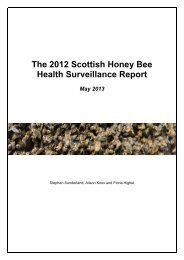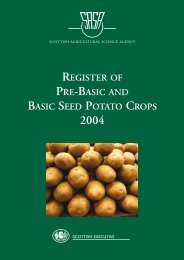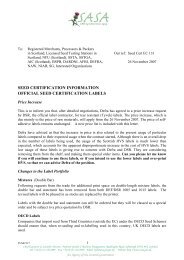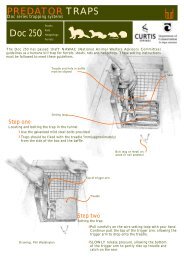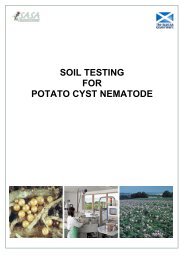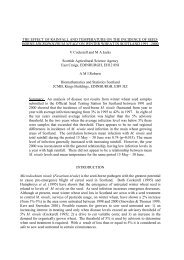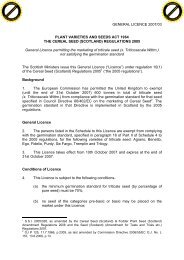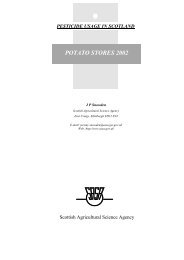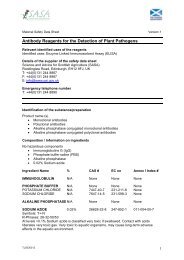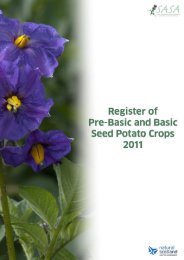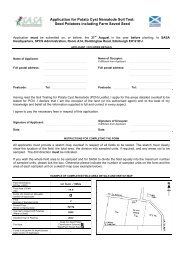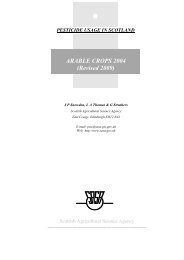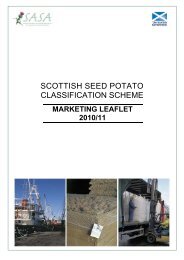Climate2. CLIMATEshadow effect). A “block<strong>in</strong>g” anticycloneover Scand<strong>in</strong>avia or <strong>the</strong> Bay <strong>of</strong> Biscay canpush <strong>the</strong> depressions fur<strong>the</strong>r west or north,result<strong>in</strong>g <strong>in</strong> generally drier, morecont<strong>in</strong>ental wea<strong>the</strong>r. In w<strong>in</strong>ter, climaticdifferences tend to run east-west whereas<strong>in</strong> summer <strong>the</strong>y run north-south. <strong>East</strong>-westdifferences also arise from <strong>the</strong> proximity to<strong>the</strong> coast, on <strong>the</strong> one hand, and mounta<strong>in</strong>son <strong>the</strong> o<strong>the</strong>r.August cereal harvest under optimal conditions,near North Berwick, <strong>East</strong> LothianThe climate <strong>of</strong> <strong>the</strong> <strong>East</strong> <strong>of</strong> <strong>Scotland</strong> istemperate without extremes <strong>of</strong> temperatureor ra<strong>in</strong>fall but, although meteorologicalcatastrophes are rare, <strong>the</strong> success <strong>of</strong>agriculture is dom<strong>in</strong>ated by wea<strong>the</strong>r. Effectscan be direct, such as <strong>the</strong> destructive<strong>in</strong>fluence <strong>of</strong> freez<strong>in</strong>g temperatures, or<strong>in</strong>direct, through <strong>the</strong> vulnerability <strong>of</strong> wetland to compaction by heavy mach<strong>in</strong>ery. Itis common for crop yield to be <strong>in</strong>fluencedby <strong>in</strong>teractions between soil type and waterrelations, or temperature.The wea<strong>the</strong>r <strong>in</strong> <strong>Scotland</strong> is dom<strong>in</strong>ated by<strong>the</strong> particular air mass pass<strong>in</strong>g over, s<strong>in</strong>ce itlies close to <strong>the</strong> track <strong>of</strong> depressions from<strong>the</strong> North Atlantic. The prevail<strong>in</strong>g w<strong>in</strong>ds arepredom<strong>in</strong>antly from <strong>the</strong> south west,br<strong>in</strong>g<strong>in</strong>g humid air, which depositsprecipitation when forced to rise over <strong>the</strong>Western and Central Highlands, and <strong>the</strong>Sou<strong>the</strong>rn Uplands. By <strong>the</strong> time that suchairflows reach <strong>the</strong> <strong>East</strong> <strong>of</strong> <strong>Scotland</strong>, much<strong>of</strong> <strong>the</strong> moisture content has been lost (ra<strong>in</strong>Francis (1981) classified <strong>the</strong> agriculturalareas <strong>of</strong> <strong>Scotland</strong> us<strong>in</strong>g mean annualra<strong>in</strong>fall, as soil water ra<strong>the</strong>r than grow<strong>in</strong>gseason length (based on temperature) is<strong>the</strong> dom<strong>in</strong>ant limit<strong>in</strong>g factor for cropp<strong>in</strong>g <strong>in</strong><strong>Scotland</strong>. He compiled tables <strong>of</strong> manymeteorological and agriculturally-relevantattributes for each area (Table 2.1).Although his calculations were based ondata from <strong>the</strong> period 1941-1970, currentfigures are broadly similar. However,variation from season to season is usuallymore important than long term averages:when decisions are be<strong>in</strong>g made aboutcapital <strong>in</strong>vestment <strong>in</strong> plant and mach<strong>in</strong>ery, abalance must be struck between <strong>the</strong> needs<strong>of</strong> <strong>the</strong> “average” season and <strong>the</strong> risksassociated with more extreme events; <strong>in</strong><strong>the</strong> shorter term, decisions on <strong>the</strong> rate andtim<strong>in</strong>g <strong>of</strong> <strong>in</strong>puts must be made <strong>in</strong> ignorance<strong>of</strong> <strong>the</strong> actual conditions to be encounteredby <strong>the</strong> crops.For land capability purposes (see Chapter3), <strong>Scotland</strong> has been mapped us<strong>in</strong>g <strong>the</strong>median value <strong>of</strong> <strong>the</strong> highest potential soilwater deficit and <strong>the</strong> lower quartile value <strong>of</strong>accumulated day-degrees above 0°C for <strong>the</strong>first six months <strong>of</strong> <strong>the</strong> year (Bibby et al.,1991; note that physiologists prefer to usedegree days). The former is really an <strong>in</strong>dex<strong>of</strong> how wet ra<strong>the</strong>r than how dry <strong>the</strong> site iswhereas <strong>the</strong> latter determ<strong>in</strong>es which cropscan be fitted <strong>in</strong>to <strong>the</strong> grow<strong>in</strong>g season17
<strong>Crop</strong> <strong>Production</strong> <strong>in</strong> <strong>the</strong> <strong>East</strong> <strong>of</strong> <strong>Scotland</strong>Table 2.1Selected climatic data for regions <strong>in</strong> <strong>the</strong> <strong>East</strong> <strong>of</strong> <strong>Scotland</strong>Borders Lothian Fife Angus & NE InvernessPerthshire <strong>Scotland</strong> & E RossGrow<strong>in</strong>g season (d) 215 225 225 220 210 215Mean w<strong>in</strong>ter temperature (°C) 5.1 4.3 5.0 4.5 3.7 4.7Mean summer temperature (°C) 12.0 11.2 12.0 11.7 10.7 11.4Last spr<strong>in</strong>g frost a Apr III Apr II Apr II Apr II May I Apr IIIAnnual ra<strong>in</strong>fall (mm) 813 675 825 912 888 803Mean PET b (mm) 465 500 473 440 415 443Access period c (d) 203 240 205 182 170 198First soil moisture deficit Mar I Mar I Mar I Mar I Mar II Mar IReturn to field capacity Oct II Nov II Oct II Oct II Oct II Oct IIIHighest summer SMD d (mm) 83 100 83 72 68 78Excess w<strong>in</strong>ter ra<strong>in</strong>fall (mm) e 310 195 320 395 368 303Source: Francis (1981);a I = first 10 days <strong>of</strong> <strong>the</strong> month etc.;b PET=potential evapotranspiration;c access for farm mach<strong>in</strong>ery;d SMD=soil moisture deficit;e ra<strong>in</strong>fall which must be removed by dra<strong>in</strong>age (i.e.allow<strong>in</strong>g for soil water recharge and evaporation)(based on temperature). W<strong>in</strong>ter wheat,barley, oilseed rape and potatoes aregenerally well-adapted to <strong>the</strong> climate <strong>of</strong> <strong>the</strong><strong>East</strong> <strong>of</strong> <strong>Scotland</strong>, with pasture grassesthriv<strong>in</strong>g <strong>in</strong> <strong>the</strong> wetter parts. Adaptedspecies <strong>of</strong> coniferous and broadleaf treesgrow well, with high yield classes <strong>in</strong>favourable locations.TemperatureAnalysis <strong>of</strong> long term records shows thatair temperatures below -15ºC or above 30ºCare extremely rare. The mean annual airtemperature, as measured <strong>in</strong> standardmeteorological screens, is about 8.5ºC for<strong>the</strong> whole area, with lower temperatures<strong>in</strong>land and towards <strong>the</strong> altitud<strong>in</strong>al limit <strong>of</strong>cultivation. The range from <strong>the</strong> coldest(January) to <strong>the</strong> warmest (July) month istypically also 8.5ºC, which is slightlygreater than <strong>the</strong> mean diurnal temperaturerange <strong>of</strong> 7ºC. As <strong>the</strong> air temperature<strong>in</strong>creases on average by only 0.33ºC perday dur<strong>in</strong>g February, March and April, latefrosts and reversions to w<strong>in</strong>ter wea<strong>the</strong>r arecommon <strong>in</strong> early spr<strong>in</strong>g. In Table 2.1 <strong>the</strong>mean date <strong>of</strong> <strong>the</strong> last spr<strong>in</strong>g frost is given<strong>in</strong> months and dekads (ten day periods).The <strong>in</strong>ter-quartile range is about fourweeks, show<strong>in</strong>g <strong>the</strong> considerable variationamong grow<strong>in</strong>g seasons.Temperatures are too low to allowsuccessful commercial grow<strong>in</strong>g <strong>of</strong> maize,sunflower or soya, although <strong>in</strong> recent yearsforage maize has been grown <strong>in</strong> <strong>the</strong> slightlywarmer South-West <strong>of</strong> <strong>Scotland</strong>. For welladaptedspecies (wheat, barley, potatoes,grassland), temperatures are generally suboptimalfor growth rate (i.e.



